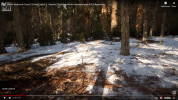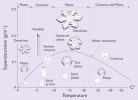I don't really understand this argument. We don't model anything realistically in realtime graphics. In shading skin, we don't model light transmission and reflection through multiple layers of different cells and oils and varying water content and blood vessels. In shading foliage, we don't model light transport through layers of cellulose wall and pigments and the air in between to get accurate light scattering. In creating hair, we don't shade the light transport through hundreds of stacked, hollow, pigment-filled, oil-covered fibres, reflecting and refracting as happens in real life. We approximate everything. Peach fuzz? Don't model hundreds of tiny hairs and shade them at the sub pixel level - add a rim-light approximation! I don't see anything about snow that makes it harder than anything else. If snow shaders are weaker than other materials, I'd say that's a lack of investment because it's a niche material, in contrast to human skin that has a lot of effort coming up with usable approximations.Unfortunately not, real life snow tends to look pretty weird and very obviously crunchy/fluffy, to the point where you can see the individual crystals from a decent distance away, the sparkle shaders we have now are a fantastically poor approximation. Not to mention how poor the heightfield hacks when walking through snow look.
There's been entire papers written on it, and researchers asked Disney for their snow physics sim from Frozen because it was the first accurate one they'd seen.
As for the physics, I thought this was a statement about the static snow in the scene. which wasn't being interacted with. Accurate snow simulation, like everything else, will be approximated somehow because it's impossible to simulate accurately. Just as lots and lots of work has been done making water realistic (which it isn't particularly, but it looks pretty good in games) the more games use snow, the more it'll be modelled. I expect it'll end up with a generic ML approximator along with other similar mixed-behaviour materials like sand.




